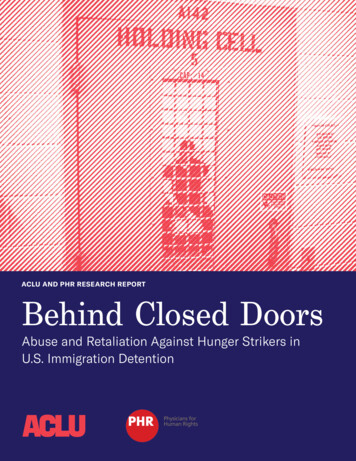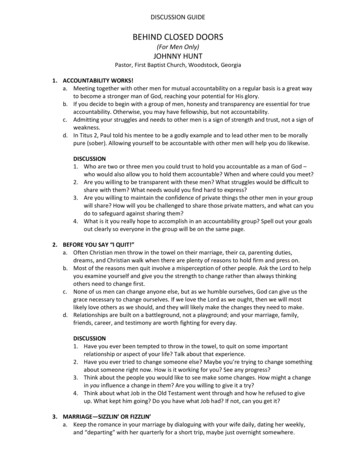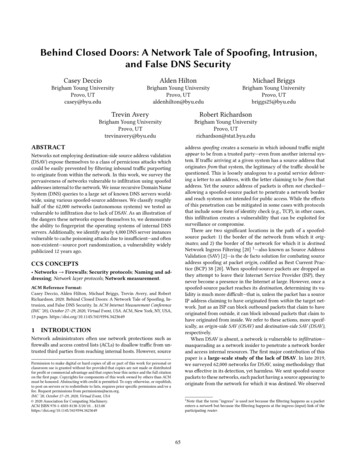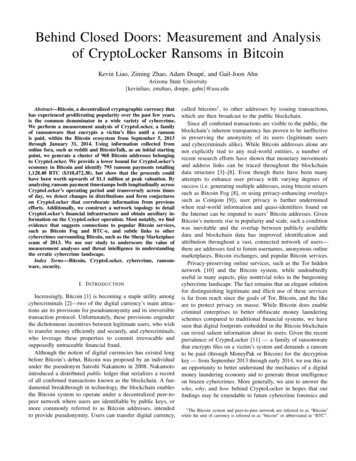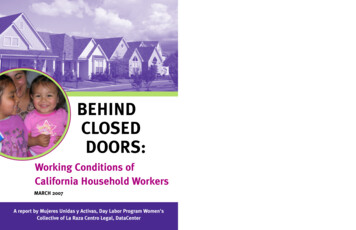
Transcription
BEHINDCLOSEDDOORS:Working Conditions ofCalifornia Household WorkersMARCH 2007A report by Mujeres Unidas y Activas, Day Labor Program Women'sCollective of La Raza Centro Legal, DataCenter
Introductionousehold workers work in the private homes of their employers,performing tasks such as in-home child, patient, and elder care,housework, and cooking. They are primarily female immigrants;some live in the home of their employer working around the clock,while others work in various households where the work is temporary and sporadic. Many are “unaffiliated” workers, meaning theyhave no connection to a hiring or temporary agency. The independent, private, often isolated nature of domestic labor means thathousehold workers often lack information about their rights orknowledge of the laws of this country and are frequently exploitedby employers. Those who are undocumented live in constant fear ofbeing deported. While supporting their employers’ homes and families, household workers frequently find themselves working in substandard and often exploitative conditions, earning poverty wagestoo low to support their own families, and lacking access to basichealth care. Their vulnerable situation subsidizes the productivity andHaffluence of the U.S. economy and yet this occupation is little understood and marginalized by the larger society and policymakers.About the StudyIn 2002, Mujeres Unidas y Activas and the San Francisco Day Labor ProgramWomen’s Collective of La Raza Centro Legal came together to analyze and tostrategize to improve the household work industry. Because there is no officialdata available about the number of household workers or information about theirwork conditions in California, these membership-based and membership-led organizations of low-income immigrant Latina women, many of whom are household workPhoto: Jill Shenkerers, joined with the DataCenter and the San Francisco Department of Public Health to create a participatory research project to assess the industry. Over thirty immigrant women weretrained to administer the survey and together they collected two hundred and forty surveys fromtheir peers in the San Francisco Bay Area. The hour-long surveys were conducted on buses, in parks, at laundromats and in the homes of household workers. As the Household Worker Rights Coalition Survey (HWRC Survey)results make clear, this is a very vulnerable industry. Rampant abuses of household workers must be addressed.Household Workers Have Families to Supporty definition, household workers support their employers’ families–they care for children, patients, or theelderly in their homes; they clean houses, do housework, or cook for their employers, often providing acombination of household services. Household workers also support their own families. Currently, as hasbeen the case historically, household workers are women of color who work in the industry for many years.BWorkers Play Critical Role in ProvidingFamily Incomeo Over half of survey respondents (54%) are primaryincome earners for their families and twenty onepercent (21%) are joint income earners.o Household workers support on average two adultsand two children.o Additionally, seventy two percent (72%) of workersalso support family in their countries of origin.BEHIND CLOSED DOORSRole in family income supportPrimary income earnerJoint income earner%54%21%Average # of family members supported #Adults2Children (under 18 years old)2Immigrant Women of Color WorkforceSupport additional family abroadSend money or packages to familyin home country72%o Nearly all (99%) were born outside the United States.Gender, race and country of originFemaleLatinaBorn outside of the United States%98%94%99%Years worked in industry1 year or less2-5 years6 years or longer%28%41%31%o Ninety-eight percent (98%) of survey respondents arewomen and ninety four percent (94%) are Latinas.%Source: HWRC Survey 2007Household Work is a Careero Survey results show household employment isa long-term occupation for a significant portionof the workforce. One-third (31%) of the workers have been in the industry for 6 years orlonger.Funded in part by grants from The California Endowment, The California Wellness Foundation, MargueriteCasey Foundation and the EDJe Fund of the Women’s Foundation of California.2TABLE 1Photo: Andrea Cristina MercadoBEHIND CLOSED DOORS3
Household Workers Face Financial Hardshipike other low-wage workers, household workers are excluded from the rising tide of prosperity in San Franciscoand California as a whole.1 Almost all household workers earn wages that are too low to adequately support theirfamilies.LTABLE 2Worker Hourly WageNo wage earned ( 0.00)Earn less than minimum wage( 0.01- 6.74)2Earn below poverty line ( 6.75- 9.06)3Earn low wage ( 9.07- 14.26)Earn self sufficiency wage( 14.27 & higher)43%11%23%44%Workers Earn Low Wages and Face WageViolationso Low wages are endemic to the industry–two thirds (67%) ofhousehold workers earn low wages or wages below thepoverty line.o In addition, eleven percent (11%) of workers earn less thanminimum wage.Source: HWRC Survey 2007Wages Insufficient to Meet Family LivingExpenseso More than eighty percent (81%) of workers do not make asufficient wage. Only 19% earn a per adult wage highenough to adequately support a family of four, althoughmore than half of household workers (54%) are primaryincome earners (see Table 1).o Nearly all workers (93%) are unable to pay basic livingexpenses such as rent and groceries.HWorkers Experience Violations withRemuneration, Overtime Payments and WorkHourso Almost all (90%) of workers who worked overtime did notalways receive overtime pay.o Thirty one percent (31%) worked more hours than agreedupon.o Nearly one-quarter (22%) of household workers were paid lessthan agreed upon with their employer.o Sixteen percent (16%) were not paid for their work at all orpaid with a bad check.TABLE 3Violations with Pay, Overtime and HoursDid not receive overtime paywhen work overtime5Worked more hours than agreedPaid less than agreed uponNot paid or paid with bad check90%31%22%16%Lack BreaksDo not receive paid work breaksDo not receive paid meal breaks83%78%Abused by Employer in last 2 monthsInsulted or threatenedSexual harassmentViolenceNo response20%9%9%35%Paid Rest and Meal Breaks Are Withheldo Eighty three percent (83%) of workers do not always receive a10-minute paid break after four hours of work.Source: HWRC Survey 2007o Seventy eight percent (78%) of household workers do not alwaysreceive a30-minute meal break after five hours of work when workingshifts of more than six hours.“Because I care fortheir children,both my employers are able towork full time,but I struggle tobuy groceries formy family and payrent each month.”Workers Experience Verbal & Physical AbuseDuring a Two Month Periodo Twenty percent (20%) of household workers are insulted orthreatened by their employers.o Nine percent (9%) of workers are sexually harassed.o Nine percent (9%) experience violence.—Reina Flamenco, Mujeres Unidas yActivas memberBEHIND CLOSED DOORSousehold workers rarely receive paid breaks as legally required. Moreover, many contend with unscrupulous oruninformed employers who violate workers’ rights to be paid as agreed for work performed and to receive overtime pay as stipulated by law. More disturbingly, emotional and physical abuse of household workers by theiremployers is prevalent in the industry.During a two-month period:19%Higher wages needed to adequately supportfamiliesWage earned NOT sufficient to pay forliving expenses(rent, groceries, childcare, bills)93%4Household Workers Are Mistreated by EmployersPhoto: Claudia Reyeso More than one-third (35%) of workers did not respond to surveyquestions about workplace abuse, a substantially higher nonresponse rate than the rest of the survey that indicates a high levelof discomfort with the questions (corroborated with survey collectors).6“We want betterwages, safeworkplaces,respectfultreatment,paid vacation,sick days andPhoto: Theo Rigbyholidays, healthcare and the right tojoin a union.”—Yesenia Perez, La Raza Centro LegalWomen’s Collective memberBEHIND CLOSED DOORS5
ConclusionHousehold Workers Are Exposed to Healthand Safety HazardsHost employees expect and are entitled to workplaces that seek to protect their health and safety. Survey findingsshow household workers commonly contend with workplace hazards, yet rarely receive safety training or protective gear to prevent injury or illness. Very few workers receive health insurance benefits from their employers.Lack of regulatory protection from the Occupational Safety and Health Administration also jeopardizes the health andsafety of household workers. The majority of workers who are ill or injured do not receive necessary medical care, primarily due to the inability to pay.MLack of Occupational Health and SafetyProtectionso Nearly two-thirds (63%) of household workers consider theirjobs hazardous, citing concentrated exposure to toxic cleaningchemicals and human contagions, risk of injury from cleaninghigh or difficult-to-reach places, and heavy lifting.o Three-quarters (75%) of household workers reported notreceiving protective gear such as facemasks or gloves to prevent workplace injuries.o Most workers (86%) do not receive training in job safety orworkplace injury prevention.Lack of Access toMedical Careo Ninety-five percent (95%)of household workers workfor employers who do notprovide health insurancecoverage.TABLE 4Occupational hazardsConsider household work dangerousor hazardousDid not receive safety equipmentDid not receive job safety trainingLack of Access to Medical CareHealth insurance not provided byemployerSuffered injury or illness requiringmedical care in the past yearNever receive medical care neededfor injuries or illnessWorker, family or friends paid formedical care received63%75%86%%95%30%64%68%Source: HWRC Survey 2007o The majority of workers who suffer an injury requiring medical attention ortreatment go without professional medical treatment (or self-treat) due primarily to inability to pay. Nearly two-thirds (64%) of workers who wereinjured or ill never receive medical care needed.o The majority of workers (68%) who did receive medical care paid for it themselves or through friends and family.6BEHIND CLOSED DOORSCalifornia must change these inadequate and unfair laws to be inclusive of these workers. Through enforcementof existing legal rights and organizing for more protections, we can improve working conditions for all household workers and combat the racism, sexism, and worker exploitation that create these conditions.What we need to ensure decent conditions for household workersEquality: Household workers should have the samelabor rights as workers in other industries.o Nearly one-third (30%) of workers had suffered an injury or illness requiring medical attention in the past year.Photo: Jill Shenkerousehold workers are not earning sufficient wages, are exposed to significant health and safety hazardsand are experiencing high rates of worker abuse. Despite these substandard workplace conditions, household workers in California are specifically and practically excluded from many labor protections.Health: Household workers lack basic health carecoverage and preventative care services. Like allother workers, household workers and their childrendeserve access to quality health care. Preventative careis critical for ensuring that workers are able to do theirjobs well without unnecessary injuries.Safety: Household workers are exposed to manyhealth and safety risks in their jobs. Household workers should be guaranteed a safe and secure workplace,just as any other worker. Currently, the OccupationalSafety and Health Administration does not regulatethe household work industry. In addition, WorkersCompensation laws should be made accessible to people working multiple part time jobs in various households.Accountability for Employers: Household workersare particularly vulnerable to employer abuse becausethey work in isolated workplaces where there is noregulation. Agencies and individual clients should bejointly liable for the worker’s rights.Protection from Discrimination: Household work-ers commonly face race, gender, and age discrimination in their jobs. However, they rarely work foremployers with more than five employees so discrimination protections do not include them. All workersdeserve protection from discrimination.Endnotes1. The population, wealth, and cost of living in the Bay Area has continued togrow over the last three decades in the midst of general economic downturn. The population of residents earning over 100,000 a year balloonedfrom seven percent to twenty-six percent from 1990 to 2000. Source: USCensus Bureau’s 2003 American Community Survey.2. During the time of the survey, minimum wage was 6.75.3. Federal poverty threshold 2004 for two adult, two-child families. Source:U.S. Census Bureau, Housing and Household Economic Statistics Division.4. Per-adult hourly wage of 14.27 and higher required by a two adult, twochild working family to pay for the basic needs of rent, food, child care,health care, transportation, miscellaneous costs and taxes in San FranciscoCounty in 2003. Source: Diana Pearce & Wider Opportunities for Women,The Self-Sufficiency Standard for California 2003.5. Figures exclude personal attendants of the elderly and disabled who normally do not have the right to overtime pay under current federal andCalifornia law.6. To correctly interpret the statistics above, it is important to keep in mindthat abuse of women is culturally normalized, to such an extent thatwomen may not identify experiences such as verbal harassment as abuse.Women who experience abuse are not likely to talk about it with familymembers, much less with strangers on a survey. Household workers are inan especially vulnerable position, often the only worker at their workplaces, and dependent on their employers for the income to support theirfamilies. Thus, they are more likely to put up with abuse to keep their jobs.BEHIND CLOSED DOORS7
Photo: Francisco DominguezDataCenter(510) 835 46921904 Franklin St., suite 900Oakland, CA 94612 USAwww.datacenter.orgDay Labor ProgramWomen's Collective ofLa Raza Centro LegalTheDataCenteris a fullyintegratedresearch, training, and strategy centerserving poor and working class communities of color organizing for socialjustice. In partnership with grassrootssocial justice organizations, theDataCenter plays an integral role inmaking information accessible, engaging communities in research, recognizing and drawing out communityexpertise, and building communitycapacity to strategically apply researchin organizing and policy work.San Francisco DayLabor ProgramWomen's Collective ofLa Raza Centro Legalis an organization ofimmigrant workers,.Workers lead our organization, especially those who have chosen to workcollectively to improve our situation.We prioritize the voices of homelessworkers, undocumented workers, andwomen workers. We combine serviceprovision with community organizing,empowering workers to take strategicaction around issues that affect us.(415) 553-3406474 Valencia St, Ste 295San Francisco, CA 94103www.lrcl.orgDesign by Design Action Collective. Printed on Recycled PaperMujeres Unidas y Activas(415) 621 81403543 18th St #23San Francisco, CA 941102647 International Blvd, suite 701Oakland, CA 94601www.mujeresunidas.netMujeres Unidas yActivas is a grassrootsorganization of Latinaimmigrant women witha dual mission of personal transformation and communitypower. Creating an environment ofunderstanding and confidentiality,MUA empowers and educates ourmembers through mutual support andtraining to be leaders in their own livesand in the community. Working withdiverse allies, MUA promotes unity andcivic-political participation to achievesocial justice.
BEHIND CLOSED DOORS: A report by Mujeres Unidas y Activas, Day Labor Program Women's Collective of La Raza Centro Legal, DataCenter MARCH 2007. By definition, household workers support their employers' families-they care for children, patients, or the


